Solidago gigantea (Giant Goldenrod)
| Also known as: | Late Goldenrod |
|---|---|
| Genus: | Solidago |
| Family: | Asteraceae (Aster) |
| Life cycle: | perennial |
| Origin: | native |
| Habitat: | sun; average to moist soil; open meadows, fields, woodland edges, roadsides, marshes, swamps, along streams and rivers |
| Bloom season: | August - October |
| Plant height: | 2 to 6 feet |
| Wetland Indicator Status: | GP: FAC MW: FACW NCNE: FACW |
| MN county distribution (click map to enlarge): |  |
| National distribution (click map to enlarge): |  |
Pick an image for a larger view. See the glossary for icon descriptions.
Detailed Information
Flower: 

![[photo of flowers]](/udata/r9ndp23q/pd/solidago-gigantea-27-t.jpg) Branching clusters of numerous small, stalked, yellow flower heads at the top of the plant. Cluster shape is variable but usually pyramidal with arching branches, sometimes more erect and plume-like, and with up to 1200+ flower heads or as few as 40 heads on smaller plants. Flowers are about ¼ inch across with usually 9 to 15 petals (ray flowers) surrounding a center disc with usually 7 to 12 disc flowers.
Branching clusters of numerous small, stalked, yellow flower heads at the top of the plant. Cluster shape is variable but usually pyramidal with arching branches, sometimes more erect and plume-like, and with up to 1200+ flower heads or as few as 40 heads on smaller plants. Flowers are about ¼ inch across with usually 9 to 15 petals (ray flowers) surrounding a center disc with usually 7 to 12 disc flowers.
![[photo of phyllaries]](/udata/r9ndp23q/yellow/solidago-gigantea-giant-goldenrod_0731_105919-t.jpg) Surrounding the base of the flower are 3 or 4 layers of narrow, lance-linear, hairless green bracts (phyllaries), the entire set of bracts (involucre) 2 to 4+ mm (to 1/6+ inch) long. Flower stalks are minutely hairy, usually shorter than the involucre, all arranged on one side of the branch (secund) and curving upward.
Surrounding the base of the flower are 3 or 4 layers of narrow, lance-linear, hairless green bracts (phyllaries), the entire set of bracts (involucre) 2 to 4+ mm (to 1/6+ inch) long. Flower stalks are minutely hairy, usually shorter than the involucre, all arranged on one side of the branch (secund) and curving upward.
Leaves and stems: 

![[photo of leaves]](/udata/r9ndp23q/pd/solidago-gigantea-13-t.jpg) Leaves are all alternate without a basal rosette, strongly 3-nerved, 2½ to 6½ inches long, ½ to 1¾ inches wide, lance-elliptic and broadest near the middle, tapering to a sharp point at the tip and tapering to a stalkless base. Edges are serrated to coarsely toothed with long, sharp teeth, though the uppermost leaves may be toothless or nearly so. Leaves are largest around mid-stem, not much smaller above, and lower stem leaves often withered away by flowering time.
Leaves are all alternate without a basal rosette, strongly 3-nerved, 2½ to 6½ inches long, ½ to 1¾ inches wide, lance-elliptic and broadest near the middle, tapering to a sharp point at the tip and tapering to a stalkless base. Edges are serrated to coarsely toothed with long, sharp teeth, though the uppermost leaves may be toothless or nearly so. Leaves are largest around mid-stem, not much smaller above, and lower stem leaves often withered away by flowering time.
![[close-up of leaf hairs]](/udata/r9ndp23q/yellow/solidago-gigantea-giant-goldenrod_0909_151446-t.jpg) The upper surface is smooth, the lower hairless or sparsely hairy on major veins, or hairy just on the midvein.
The upper surface is smooth, the lower hairless or sparsely hairy on major veins, or hairy just on the midvein.
![[photo of stem]](/udata/r9ndp23q/yellow/solidago-gigantea-giant-goldenrod_0731_115038-t.jpg) Stems are erect and rigid, hairless and smooth throughout except minutely hairy in the flower clusters, and often reddish, with or without a whitish waxy bloom. Insect galls are common on the lower half of the stem. Stems are single to many in a group from underground creeping rhizomes, often forming colonies.
Stems are erect and rigid, hairless and smooth throughout except minutely hairy in the flower clusters, and often reddish, with or without a whitish waxy bloom. Insect galls are common on the lower half of the stem. Stems are single to many in a group from underground creeping rhizomes, often forming colonies.
Fruit: 
![[photo of fruit]](/udata/r9ndp23q/pd/solidago-gigantea-1016-1-t.jpg) Fruit is a dry seed (achene) with a tuft of whitish hairs (pappus) 2 to 2.5 mm long attached at the tip to carry it off in the wind.
Fruit is a dry seed (achene) with a tuft of whitish hairs (pappus) 2 to 2.5 mm long attached at the tip to carry it off in the wind.
![[photo of achenes]](/udata/r9ndp23q/pd/solidago-gigantea-112916-t.jpg) Achenes are brown, sparsely hairy, oblong to narrowly cone-shaped, 1.3 to 1.5 mm long.
Achenes are brown, sparsely hairy, oblong to narrowly cone-shaped, 1.3 to 1.5 mm long.
Notes:
The “Canada Goldenrod complex” in Minnesota consists of Solidago canadensis, S. altissima, and S. gigantea (related S. missouriensis and S. juncea are not technically included but are also similar except have basal leaves). They can be a tough group to crack, but Giant Goldenrod is the easiest to identify from its hairless stems, often with a waxy bloom, and toothy leaves that are hairless or only sparsely hairy on major veins, or just the midvein. The panicle is typically large and open, to over 12 inches wide and 20 inches tall on a robust plant, though more typically about half that size.
S. canadensis and S. altissima are both distinguished from S. gigantea by their hairy stems and (usually) hairier leaves. While S. juncea and S. missouriensis do also have hairless stems, they are much shorter plants, usually under 3 feet tall, and for both basal clumps are common, lower leaves are stalked, and leaves become much smaller as they ascend the stem.
Native Plant Nurseries, Restoration and Landscaping Services ↓
More photos
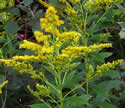 Giant Goldenrod plants
Giant Goldenrod plants Giant Goldenrod plants
Giant Goldenrod plants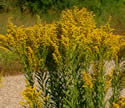 Giant Goldenrod plants
Giant Goldenrod plants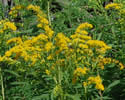 Giant Goldenrod plants
Giant Goldenrod plants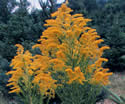 Giant Goldenrod plants
Giant Goldenrod plants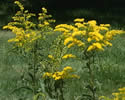 Giant Goldenrod plants
Giant Goldenrod plants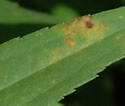 more leaves
more leaves more leaves
more leaves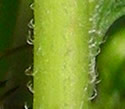 stems are minutely hairy only in the flower clusters
stems are minutely hairy only in the flower clusters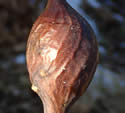 comparison of Solidago altissima and S. gigantea stem galls
comparison of Solidago altissima and S. gigantea stem galls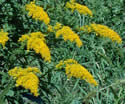 flower clusters can be very large and showy
flower clusters can be very large and showy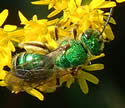 pollinators
pollinators
Photos by K. Chayka taken in Ramsey County. Photos by Peter M. Dziuk taken in Anoka, Dakota, Hennepin, Isanti, Ramsey and Washington counties.
Comments
Have you seen this plant in Minnesota, or have any other comments about it?
on: 2019-09-02 20:23:16
Plants are outside our home. We have live here since 2003, have some in a little meado with other Native species. This year is a big patch i was taking pictures of the Goldenrod for a friend in Colombia, and commenting about the bees and that i need to cut them before our daughter come home, she is allergic to it, I have 2 grand children don't know if they have inherited their mother's allergies






